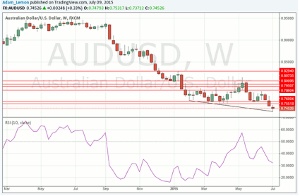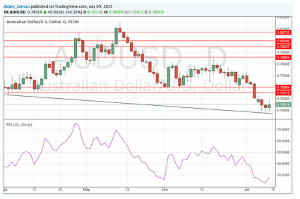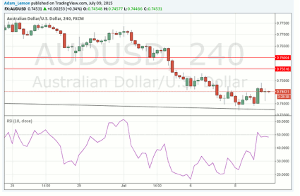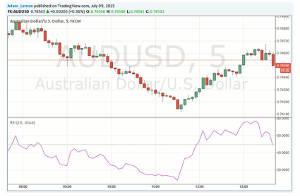Typical use of forex indicators can actually cause an inexperienced trader to lose money rather than make it, but if a trader is going to use one, Adam Lemon, of DailyForex.com, explains why he thinks the best one to use is the RSI (Relative Strength Indicator) since it reflects momentum.
Although it may sound counter-intuitive, typical use of forex indicators can actually cause an inexperienced trader to lose money, rather than make money. However, if you are going to use one, the best forex indicator is the RSI (Relative Strength Indicator) because it reflects momentum and it is well established that following forex momentum can give you a winning edge. The RSI is a forex momentum indicator and it is the best momentum indicator. If you are going to use the RSI, the best way to use it is to trade long when it is showing above 50 on all time frames, or short if below 50 on all time frames. It is best to always trade with the trend of the last ten weeks or so.
What's the RSI (Relative Strength Index)?
The Relative Strength Index formula was developed in the 1970s, like so many other technical analysis concepts. The Relative Strength Index calculation is made by calculating the ratio of upward changes per unit of time to downward changes per unit of time over the look-back period. The actual indicator calculation is more complex than we need to worry about here.
What is important to understand is that if the look-back period—for example—is ten units of time and every single one of those ten candles closed up, the RSI will show a number very close to 100. If every single one of those ten candles closed down, the number will be very close to 0. If the action is completely balanced between ups and downs, the RSI indicator will show 50.
The Relative Strength Index definition is as a momentum oscillator. It shows whether the bulls or bears are winning over the look-back period, which can be adjusted by the user.
Relative Strength Index Technical Analysis
The RSI indicator is typically used in forecasting and trading strategies in the following ways:
- When the RSI is over 70, it should be expected to fall. A fall below 70 from above 70 is taken as confirmation that the price is beginning a move down.
- When the RSI is under 30, it should be expected to rise. A rise above 30 from below 30 is taken as confirmation that the price is beginning a move up.
- When the RSI crosses above 50 from below 50, it is taken as a signal that the price is beginning a move up.
- When the RSI crosses below 50 from above 50, it is taken as a signal that the price is beginning a move down.
What's the Best Way to Use the RSI?
The third and fourth methods described above—regarding the cross of the 50 level—are generally superior to the first and second methods concerning 30 and 70. That is because better long-term profits can be made in forex by following trends than by expecting prices to always bounce back to where they were: just be careful not to move stop losses to break even too quickly.
The best way to trade crosses of the 50 level is by using the indicator on multiple time frames of the same currency pair.
NEXT PAGE: The Intelligent Way to Use an Indicator
|pagebreak|Multiple Time Frame Cross of the 50 Level
Open multiple charts of the same currency pair on several time frames: weekly, daily, H4, all the way down. Open the RSI indicator on all the charts and make sure the 50 level is marked. Practically all charting programs or software includes the RSI so it should not be difficult. A good look-back period to use in this indicator is 10. It is also important that the look-back period is the same on all the different time frame charts.
If you can find a currency pair where all the higher time frames are either above or below 50 and the lower time frame is the other side of 50, then you can wait for the lower time frame to cross back over the 50 and open a trade in the direction of the long-term trend.
The higher or lower the RSI value is, the better the trade is likely to be. It is an iron law of the markets that strong trends are more likely than not to keep going and that a retracement that then turns back around tends to move nicely in the direction of the trend. This method is an intelligent way to use an indicator: it identifies retracements within strong trends and tells you when the retracement is likely to be ending.
Short Trade Example
An example is shown below using the AUD/USD currency pair in several time frames, with the RSI indicator set to a look-back period of 10. It is below 50 on the weekly, daily, and 4-hour time frames and is just crossing from above 50 to below 50 on the 5-minute time frame. This could be interpreted as a signal for a short trade.
There is no reason why this cannot be combined with other strategies such as support and resistance, moving average crossovers, time of day, etc.
It can also be used as a day trading strategy when you are prepared to drop down to low enough time frames.
Weekly:
Daily:
4 Hours:
5 Minutes:
Note: this is not a perfect example, as it would have been better if the Hourly time frame also showed the RSI below 50. Best results are obtained when there is no big gap between the time frames that are used.
By Adam Lemon, Contributor, DailyForex.com

























